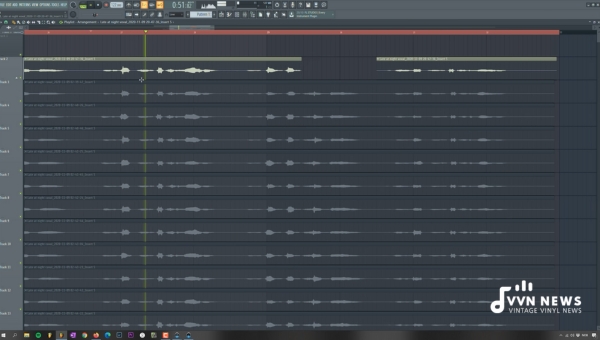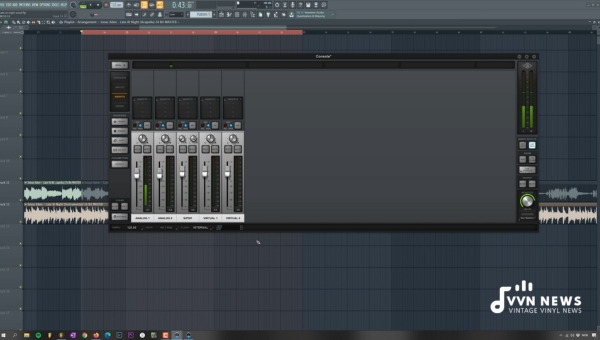If you’ve ever tried your hand at studio recording, chances are you’re familiar with the intricate dance that captures and perfects the human voice.
Smooth vocals can transform a good track into a hit, while a poorly recorded voice can take away its shine.
With this in mind, I’ve decided to gather my tried-and-true techniques and share with you 25 Tips for Recording and Mixing Vocals.
In this era of technology where every device is potentially a recording studio, each one of us can create music right from our bedrooms.
But diving into the world of audio production might feel like stepping into unchartered territory without the right tools in hand.
A carefully compiled guidebook to better your recording game and render vocals that sound professional and compelling – ready to charm audiences.
What is Vocal Recording and Mixing?
Vocal recording and mixing are two crucial steps in the music production process that play a pivotal role in setting the mood, emotion, and overall feel of a song.
Vocal recording entails capturing the singer’s voice using a microphone, while vocal mixing involves tweaking recorded vocals to sound their best within the context of the entire mix.
The Recording Process
When we talk about vocal recording, we generally mean the process of capturing raw vocal sounds.
This includes picking up every detail, from tonal nuances to breath control.
The goal here is to capture an accurate representation of what’s happening in the studio, which then forms our foundation for subsequent steps.
Factors like mic placement can significantly influence how vocals sound during this stage.
For example, if a mic is placed too close to a singer’s mouth, it might pick up popping sounds produced during plosive consonants like ‘p’ and ‘b’.
By contrast, keeping too much distance could lead to ambient noise entering your track.
The Mixing Process
After you’ve nailed down your recording process with clean and full-bodied vocals as your result, you move on to mixing – often considered an art in itself within music production circles.
Here, things get particularly interesting. Mixing involves manipulating multiple layers of audio into one cohesive track.
The aim is to achieve balance and harmony through tools such as equalization (EQ), compression, reverb, and delay ensuring that vocals fit perfectly with other elements like drums or guitars in the mix.
In both these tasks recording and mixing having the right knowledge and understanding can make all the difference between producing an amateurish high-school talent show quality track or engineering a potential chartbuster.
Also Read: Flute Vs Recorder [Which Instrument Is Best For You?]
Importance of Good Vocal Recording and Mixing Techniques

The voice is often the centerpiece of a song, carrying the narrative, emotion, and melody.
It’s crucial that the vocal recording and mixing are done proficiently. Good techniques provide detailed, clean, and transparent sound quality, significantly enhancing the overall listening experience.
Preserving Sound Quality
Vocals that are recorded properly reduce the risk of unwanted sounds and noises being picked up by the microphone.
This preserves the integrity of the vocalist’s voice, tone, and diction. Not to mention greatly minimizes post-production efforts in cleaning up the track.
Enhancing Emotion & Dynamics
Recording and mixing done right help convey emotions more effectively to listeners. You can enhance quiet moments to be more intimate or make loud ones more impactful through proper compression and EQ techniques.
Creating a Professional Track
A well-recorded vocal can add an unmistakable professional quality to your music. It makes your tracks aspirational, taking them from just another song on a streaming platform to something an enthusiastic listener might want to download and listen on repeat!
Improving Listener Experience
Excellent recording and mixing ensure your listeners are enjoying every beat without being distracted by pops or hiss in vocals – improving their overall musical experience.
Also Read: DIY Vocal Booth [Set Up Home Recording Studio on A Budget]
25 Tips for Recording and Mixing Vocals
When crafting a song, the vocal track is often the centerpiece. So let’s begin by sharing 25 ‘must-know’ tips that’ll help you while recording and mixing vocals.
1. Mic Placement
This is one of the most crucial factors when recording vocals. The position and distance of the mic from the singer can drastically change the sound of the vocals.
To get a balanced, clean recording, start by placing the mic about 6-12 inches away from the vocalist. This distance usually captures a good balance of direct sound from the voice and reflected sound from the room.
Try different mic placements on each recording session. Aim for an inch closer or further each time until you find your ‘sweet spot’. A little trial and error here can give your vocals that distinct edge you were looking for.
2. Proper Mic Selection
Much like how a painter chooses their paintbrush, selecting an appropriate microphone is fundamental to capturing quality sound.
The choice between large-diaphragm condenser mics and dynamic mics depends largely on what you’re looking for in your recording.
Dynamic mics are typically more robust and can handle louder volumes but may lack some detail in lower-volume recordings.
Condensers, on the contrary, capture more detail across various frequencies but might distort if volumes get too high.
Making this choice depends on several factors: style of singing, type of song, tonal quality desired, and even budget considerations.
Some popular options for studio recordings include microphones like Neumann U87 or Shure SM58.
3. Acoustic Treatment
When it comes to recording vocals at home, controlling room sound can be quite challenging without acoustic treatment.
Acoustic treatment sounds quite technical; however, it’s all about controlling unwanted noise and echoes in your space by using absorptive materials to ‘treat’ surfaces that cause such disruptions.
You could invest in professional-grade bass traps and diffusers or try DIY methods as simple as installing heavy curtains or using defined areas with lots of soft furnishings to dampen sound reflections thereby getting cleaner vocal tracks without unwelcome reverb.
4. Warm-ups Exercises
Warming up pre-recording might seem like an exercise reserved for stage singers alone – Trust me, it isn’t!
Just as athletes wouldn’t dream about performing at peak capacity without a pre-match warm-up routine so too should vocalists.
Start with deep breathing exercises to prepare your respiratory system followed by soft humming – progressively expanding into full-throated singing gradually over 20 minutes at least will do wonders for achieving steady pitch control when hitting that record button!
In addition to helping relax measurably improving tonal quality warming up also helps prevent potential damage to singers’ voices over time.
5. Vocal Editing
Once you’re done with the recording, it’s time to delve into vocal editing – the stage where you make your raw vocal tracks sound more polished and professional.
Begin by nudging or shifting individual words or phrases to tighten up the timing of your vocals. This gives a finesse to synchronization that’s often crucial for a professional sound.
Next, tuning is a subtle but stellar tool at your disposal. While software like Melodyne or Auto-Tune seems miraculous, ensuring that they don’t leave their footprint on your mix involves delicate control over their utilization.
Consistency plays a major role in vocal editing as well. Tools like automation or clip-gain can be used to handle inconsistencies in your vocal tracks.
6. Vocal Range Awareness
A singer who knows their range is akin to an archer who has precise knowledge of his bow’s reach – both can aim their shots perfectly!
Encourage singers to be conscious of their vocal limits knowing when too much strain could potentially harm voice quality or lead them astray from captured pitch intent.
It implies selecting ideal keys for duets so both singers shine rather than pitch-struggle for the limelight.
7. Mic Preamp Quality
Even with the best mic selection, without quality preamplification, your signal will never reach its full potential but finding yourself overwhelmed when pinpointing the right preamp among countless options isn’t surprising!
When selecting a mic preamp, consider features such as tone coloration and distortion effects alongside basic gain functionality.
Brands like Neve, API & Avalon are renowned for imparting certain warmth and character to vocals; while others like Universal Audio Apollo offer pristine clean gain!
To strike that balance seems daunting but remember you’re investing toward defining the genre-specific tonal character of your mixes!
8. Proper Gain Staging
When dealing with digital audio workstations (DAW), it’s essential to set the correct input level referred to as ‘gain.’
A friendly guideline I follow: high enough so it’s above the noise floor (the constant white noise produced by all electronic gear), but low enough so it doesn’t clip. Overloading signals results in distorted recordings often irreparable during post-production
Recording at about -18dBFS leaves ample headroom thus safeguarding against unexpected loud singing bits.
9. Clear EQ Cutting
Equalization, or EQ for short, is an absolute must in vocal mixing as it can either clarify or mar your mix.
Clear EQ cutting involves eliminating specific frequencies that are muddying the mix or causing conflict with other instruments.
To start, you’d typically use a high-pass filter to cut low frequencies that may produce a muddy sound.
The cut-off frequency depends on the vocalist’s range and the song’s needs but typically, anything below 80 Hz can be safely eliminated for vocals.
It might seem counter-intuitive but cutting some frequencies cay make your vocals stand out more in your mix by making room for them to breathe. It’s all about balance!
10. Subtle Compression
Compression is one of those things you don’t know you need until you hear it in action – suddenly everything sounds more professional!
In essence, compression works by reducing the dynamic range – the difference between the loudest & quietest parts of the vocal track; thereby allowing great consistency & control over volume levels.
While setting up compressors it is extremely important to use them subtly else risk losing the expressiveness & dynamic impact inherent in a human voice.
As a practice, I’d recommend starting by setting a ratio around 2:1 to 4:1 with attack and release times set fairly fast – around 10 ms and 50 ms respectively.
Also Read: Parallel Compression 2025 [What It Is & How To Setup?]
11. Parallel Processing
Parallel processing is an advanced mixing technique where we duplicate a vocal track; apply heavy compression to duplicate leaving the original untouched; and then blend both together achieving an energetic vocal sound that retains the expressiveness of the original alongside the power of a heavily compressed track.
This allows adding body & incise tone while maintaining subtle details inherent in the human voice thereby creating a ‘larger than life’ vocal vibe so beloved in contemporary mixes! It’s also called ‘New York Compression’ by some.
12. Vocal Doubling
Vocal Doubling – another powerful technique where the singer records the same part twice (it’s not simple copy-pasting!).
Both tracks are then played together creating a thick layered effect adding depth and richness.
The key though lies in maintaining consistent timing and pitch across both tracks else we end up with phasing issues turning richness into annoyance quickly!
Keep in mind this technique works especially well when doubling softer verses lending them enough weight to stand out against backing music elements or adding drama to choruses making them stand out!
13. De-Essing
It is common for ‘S’ and ‘T’ sounds to come out quite harsh in your vocal recordings.
This is where a de-esser, a type of compressor, becomes indispensable. Essentially, it reduces the volume of sibilant, or hiss-like, sounds that are commonly over-emphasized in recordings.
When setting up a de-esser, you select the problematic frequency range (usually between 5-8 kHz for vocals) and decide how much reduction you want to apply.
14. Reverb and Delay
Reverb and delay, when used judiciously, can add depth and breadth to your vocal tracks.
Reverb recreates the natural reflections of sounds in different physical environments such as rooms or halls. By adding reverb to your vocal tracks, you simulate singing in more reflective spaces to enhance warmth and depth.
Delay, also known as echo, repeats a sound at intervals after it’s played. This can help create an illusion of space around vocals making them appear fuller.
Remember: Less is often more with these effects! Moderation ensures clear vocals that don’t get lost in this added ‘space’.
15. Panning Techniques
Panning adjusts the balance between left and right speakers allowing you to direct your listeners’ attention across the stereo field.
You might use panning for creating layers with multiple vocal tracks or achieving separation between different elements within your song mix like separating lead vocals from backing ones ensuring clarity without conflicts.
Try positioning main vocals in the center with backing vocals or harmonies slightly panned on either side creating fuller yet balanced soundscapes.
16. Vocal Automation
Automation refers to the painstaking process of manually adjusting volume levels at various points throughout the song ensuring a consistent listening experience and avoiding peak drops–a key factor while mixing professionally sounding records.
In DAW (Digital Audio Workstation) typically automate various parameters like level pitch pan position even effects applied letting you have real-time control over every element track–including those elusive-to-perfect vocals!
17. Harmonic Exciters
Harmonic exciters are vital tools that add life to your recordings without causing distortion.
Essentially, they generate harmonics (additional frequencies) to enrich the original sound, helping to enhance clarity and presence.
They bring out the “sparkle” or “airiness” of vocals that sound so captivating in professional mixes.
Use an exciter sparingly as it can add unnecessary noise when overused. Start with a lower setting and gradually increase until you notice a positive change in vocal tonality.
18. Multiband Compression
One of the most powerful tools for controlling the dynamic range of your vocals is multiband compression.
Unlike standard compressors that treat all frequencies equally, multiband compressors allow you to control different frequency ranges independently.
This comes in handy when dealing with complex vocal performances with varying dynamics across different frequencies.
To effectively apply multiband compression, first identify the problematic frequencies in your track. Apply compression within those specific bands only rather than affecting the entire performance.
Also Read: What Is Tape Saturation And Plugins? [Top Saturation Plugins]
19. Saturation Effects
Saturation is not merely a byproduct of old-school analog recording; it’s an effect we’re wired to find pleasing and warm one that can breathe new life into seemingly plain-sounding vocals.
Digital recording tends to be clean and precise but often lacks character when compared to older analog processes which naturally imbued coloration or ‘saturation’ as they overloaded.
Nowadays, many plugins crisply reproduce this effect offering controlled saturation effects making sure your vocals come off fuller, richer, and undeniably warmer!
20. Vocal Bus Processing
Vocal bus processing is an essential mixing process where all vocal tracks are routed through a single ‘bus ‘ for group processing.
Applying effects directly on each vocal track can cause disparities making them sound disconnected from each other potentially breaking the overall cohesion of the song.
Linking them through a bus allows the application of common EQ, reverb, or compression settings ensuring they ‘gel’ together beautifully while still retaining the chance for further individual track adjustments later if needed!
This technique not only yields balanced-sounding vocals but also saves crucial CPU load as using one compressor or EQ across multiple tracks tends to be less taxing than applying separate instances for each one.
21. Vocal Riding
Vocal riding is a technique that plays a crucial role in the mixing process. It involves manually adjusting the volume level of a vocal track to maintain a consistent loudness throughout the piece.
Some parts of your vocal performance may be louder than others and some words or phrases might get lost in the mix. This is where vocal riding comes in.
You can do this manually by listening to the track and noting down areas where vocals are too loud or too soft, then tweak these areas using your Digital Audio Workstation (DAW). Alternatively, there are plugins available that can do vocal riding for you – but remember, no tool can replace the human ear for judgment!
22. Final Polishing
The final polishing stage includes adding any finishing touches to make your vocals shine.
These could include things like subtle EQ adjustments, applying spatial effects like reverb and delay judiciously for added depth and character, or even automating some final tweaks in volume to make sure everything sits perfectly in the mix.
This last step is subjective and solely depends on one’s taste and desired outcome. That’s where you get to experiment, bring out your creative side, and add that personal touch just like an artist signs off their masterpiece!
23. Pop Filter
Any recording enthusiast would vouch for how indispensable a pop filter is! These screen-like devices are placed between the singer and the microphone to diffuse bursts of air produced by ‘plosive’ consonants like ‘p’ & ‘b’.
By spreading out this air pressure, pop filters help prevent distortion, maintain clearer audio quality & protect delicate mic elements!
24. Mic Preamp Quality
A microphone preamp takes the small signal from your microphone & amplifies it making it much stronger for further processing on your mixer or audio interface.
A good microphone preamp enhances transparency & provides an accurate depiction of the original sound while lesser quality ones often color sound or might introduce unwanted noises during amplification stages.
Choosing wisely here could therefore mean the difference between pure high-definition sound or anything short of it!
25. Double Tracking
Double tracking is an age-old studio trick used primarily to achieve a fuller sound without making vocals muddy! Essentially means recording the same part twice; and layering them together during the mix.
Besides just giving more substance & depth to your track – this technique offers certain natural imperfections between multiple takes thus adding interesting texture & life within the final mix too!
Practice makes perfect when it comes to double tracking – So keep experimenting till you get the desired sound nailed down right! In the world of music production – those willing to explore often find gold.
Also Read: What Is A Session Musician? [Skills, Qualities, & Earnings]
FAQs About Recording and Mixing Vocals
What are the key factors in achieving a quality vocal recording?
To get a high-quality vocal recording, it’s essential to focus on three primary factors: the performance, the room acoustics, and the equipment used.
Do I need expensive equipment to record vocals?
While a professional microphone will give you better audio quality, I cannot overstate the importance of utilizing what you have efficiently. Good practices and techniques often outvalue high-end equipment.
How crucial is the room I am recording in?
The room’s acoustics can profoundly impact your recording. For optimal results, choose a small to medium-sized room without hard surfaces that may cause unwanted echo or reverb effects.
Why is correct microphone placement important?
Correct mic placement ensures that the full breadth of the performer’s vocal range is captured. It also helps in controlling unwanted noise and excess sibilance or plosives.
What does mixing vocals mean?
Mixing vocals involves blending multiple vocal tracks and using techniques such as compression, equalization, and reverb to enhance clarity and balance about other mix elements.
Conclusion
In the journey of audio production, the role of knowledge cannot be overstated.
These steps, rather than 25 tips for recording and mixing vocals, should serve as a sound map, guiding you toward capturing and perfecting vocals. But remember, it’s not just about following rules.
Don’t be afraid to experiment with various techniques until you find what works best for your unique sound. Every artist’s greatest instrument is the voice – treat it with care while recording and mixing!








